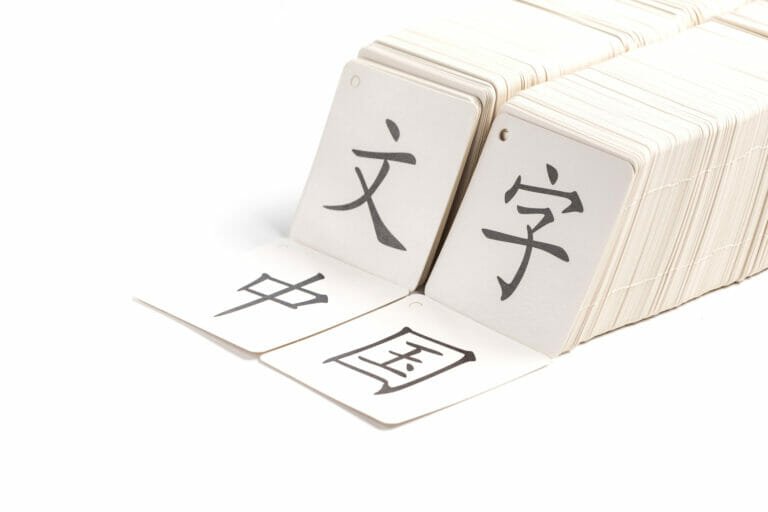When learning Chinese, remembering new Chinese words can be challenging. In this article, we share some tips that will make it easier to remember the Chinese characters and words you learn more effectively.
1. GET EXPOSED TO MORE CHINESE WORDS
When trying to remember Chinese words, it helps to be exposed to words repeatedly.
For example, you can put Chinese name tags on things you use daily.
First, check the dictionary to find the word you want to learn, such as ‘computer mouse’ shǔbiāo 鼠标. Write the name down on a piece of paper and then attach it to the mouse.
When you use the mouse, as you probably do several times a day, you will see the label with the Chinese word. In the beginning, you can start with pinyin (the way you pronounce the word). Later, once you are familiar with the word, you can add Chinese characters to the name tag.

2. LEARN PATTERNS OF CHINESE CHARACTER RADICALS
For some Chinese characters, one can learn the words in groups according to their radicals or the roots of the Chinese character. Learning words in groups according to their radicals will make it easier to recognize new Chinese characters.
An example is the radical 氵, which many also call 三点水 (sān diǎn shuǐ / 3 drops of water) or shuǐ (water).
Chinese characters with this radical usually refer to something wet: hé 河 river, hǎi 海 sea, làng 浪 wave, chí 池 dam, hú 湖, hàn 汗 sweat, yè 液 liquid, etc.
3. FOCUS ON PRONUNCIATION AND READ ALOUD
As you begin to learn Mandarin Chinese, it is important to focus on pronouncing the Chinese words correctly. You should read aloud and follow vocabulary and sentences.
And if you take a Mandarin Chinese course, the Chinese teacher will correct you. If you pronounce a word incorrectly, the Chinese teacher will tell you how to pronounce it correctly and how to use the word in practice.
Since Chinese is a tonal language, different pronunciation means different words. Do not mix the notes. This will make the Chinese do not understand what you are trying to say.
For example, if you say: ‘xióngmāo’ 熊猫 with a second and a first note, this means panda. If you mix the tones and say ‘xiōngmáo’ 胸毛 with the first note and the second note, this means chest hair.
4. LEARN SOUND COMPONENTS IN THE CHINESE CHARACTERS
You may have tried to memorize Chinese words without knowing what the word in front of you means or how to pronounce the word.
One way to identify the pronunciation of a Chinese character is to find sound components within certain characters.
For example, you can find the ma 马 component in many characters: 吗,妈 , 骂 , 码 with a ma pronunciation.
Although the tone of these characters is not the same, identifying the ma 马 sound will help you with the characters.
5. WRITE THE CHINESE CHARACTERS YOU LEARN
Although it may seem like a very traditional way of studying, it is useful to write Chinese characters with pencil and paper. This will help you feel the flow of the Chinese character you have written. The more you write the characters you learn, the easier it is to remember them when you see them.
You can obtain a TIAN ZI GE NOTEBOOK as a supplement to Chinese language studies. You can use this type of notebook to practice writing Chinese characters. Each square containing one character is divided into four quadrants, which guide the correct placement of each element in the Chinese characters you learn to write.
Both children and adults who learn Chinese characters and how to write Chinese can use a TIAN ZI GE NOTEBOOK.
6. TAKE A CHINESE COURSE
If you take a course in Chinese, you will have a systematic way of learning the words and signs. You will receive immediate feedback on pronunciation from the Chinese teacher.
An effective way to correct the mistakes you make when you pronounce, read and write Chinese characters incorrectly and are corrected in class.
In other words, it is not only important to get instruction on how to do it right by the Chinese teacher, but also how to correct the mistake you have made.
The Chinese class will give you new perspectives, and the interaction with the teacher will inspire you. You will learn the language more effectively and gain a better understanding of Chinese culture.
DO YOU WANT TO LEARN MORE MANDARIN CHINESE OR KNOW SOMEONE WHO WANTS TO?
If you want to learn Mandarin Chinese, feel free to REGISTER FOR A FREE TRIAL CLASS HERE or send me an email (Chen Huimin):huimin@laerkinesisk.no.
We offer private lessons and group classes at all levels, HSK 1-6, children, adults, business. All Mandarin Chinese classes are offered in classrooms or online.
Do you know anyone who wants to learn Chinese? We will give you 500 US dollars as a bonus as a part of our program “Refer a friend – get $ 500” if your friend or others you introduce to us start taking Chinese classes at our school. Register here if this is interesting for you!


















